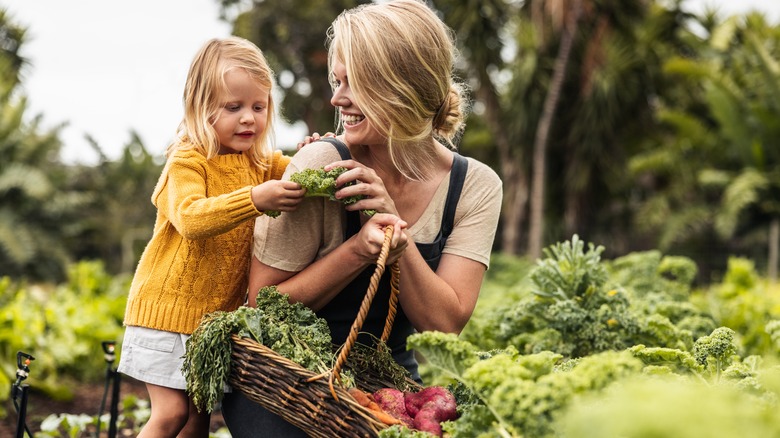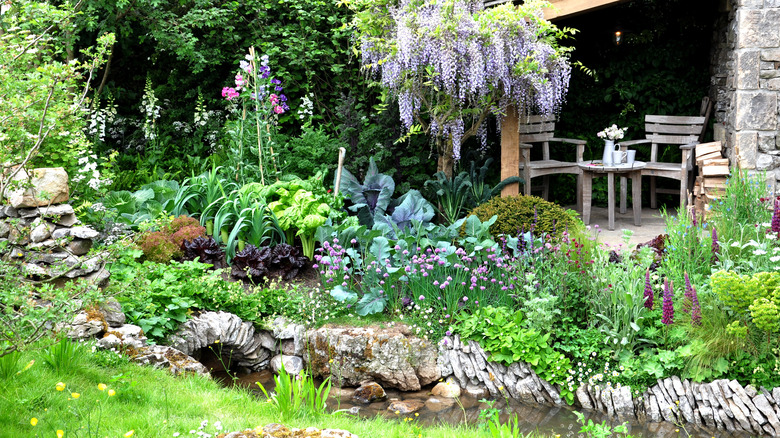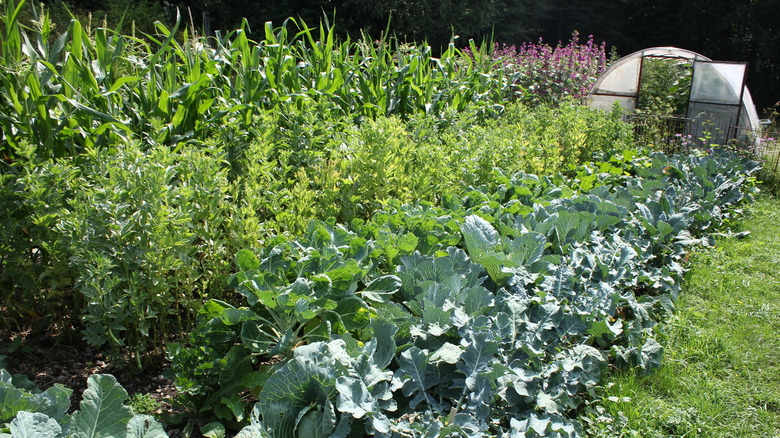'Foodscaping' Can Transform Your Grass Into An Edible Lawn
The term might throw you for a loop at first, but 'foodscaping' is a relatively simple concept that anyone can incorporate into their yard. At its core, foodscaping is an alternative to typical suburban lawns that uses edible plants to maximize ground cover. With foodscaping, you can not only fill your yard with beautiful fruits and foliage, you can also fill your plate with more fresh and organic foods. Closely related to permaculture and the anti-lawn movement, foodscaping is better for the environment and anyone living on a tight budget.
Every day across the United States, about 9 billion gallons of water are poured into lawns and gardens, so it makes sense that homeowners should try to capitalize on that resource investment and swap out their weak and water-hogging lawns for beautiful and tasty garden plants (via the Environmental Protection Agency). Don't be afraid to rip up your grass and give your green thumb a go! While it may seem like a big change, some plants are a foodscaping match made in heaven, and they can quickly turn your yard from a barren wasteland to a garden of Eden. Here's how you can pull off the lush, delectable look.
Picking the perfect plants
The key to a thriving foodscape is to consider your native environment and temperature zone. Some species may thrive better in your area than others, but you should be able to find garden plants to suit the four essential layers in landscape design: ground layer, foreground, mid-ground, and background. While foodscaping mostly uses garden plants, don't forget about edible grasses — many species of grass and clover are actually edible! For filling in ground cover, stick to low-lying options like wood sorrel, lingonberry, creeping thyme, and purslane.
Kale, arugula, lettuce, squash, cucumbers, radishes, and carrots offer good foreground cover and are ideal for edges and walkways where they can be easily tended. Low-growing fruits like strawberries, blackberries, and raspberries are very easy to grow and produce beautiful blooms in spring and summer, but may do best in hanging planters to avoid insects. Add interesting texture and fragrance to your foreground with herbs like rosemary, fennel, chamomile, and lemon balm.
Some good options for mid-ground foodscaping include blueberries, peppers, jalepeños, and tomatoes, which are relatively animal-resistant and will bring color to your yard in summer. Corn stalks, nut trees, and fruit trees are ideal for creating a landscape background and providing shade over plants that need it. Even those with desert landscapes can engage in foodscaping by looking for drought-tolerant and edible native plants like prickly pears, loquats, and persimmons.
Plotting and harvesting your foodscape
Vegetable gardens are often portrayed as difficult and muddy, but they can be just as beautiful as a stylized landscape. When planning your foodscape layout, plants don't have to be in perfect rows. In fact, it can look better to have mixed species in different areas. Think outside the usual gardening box and play around with free-form shapes and natural nooks throughout your whole lawn, just be sure to consider irrigation, shade, and companion plants, as not all plants will have the same care needs. Experiment with height and color by filling each corner of your yard with different fruit trees, edible greens, shrubs, vines, and flowers. Keeping blooms nearby will bring more pollinators into your yard and help your vegetables proliferate. For anyone still feeling timid about all-out foodscaping, an even more low-maintenance option is to create raised garden beds and fill in pathways with a weed barrier and gravel or clover.
Foodscaping is more than an outdoor design trend; it's a movement to support a healthier community and planet. Encourage your whole household to spend more time in the garden by installing cozy lighting, benches for quiet time, and lounge areas. To fully embrace the lifestyle and learn more helpful tips, connect with other nearby foodscapers, trade frequently with neighbors, and donate spare produce to support local families in need.


